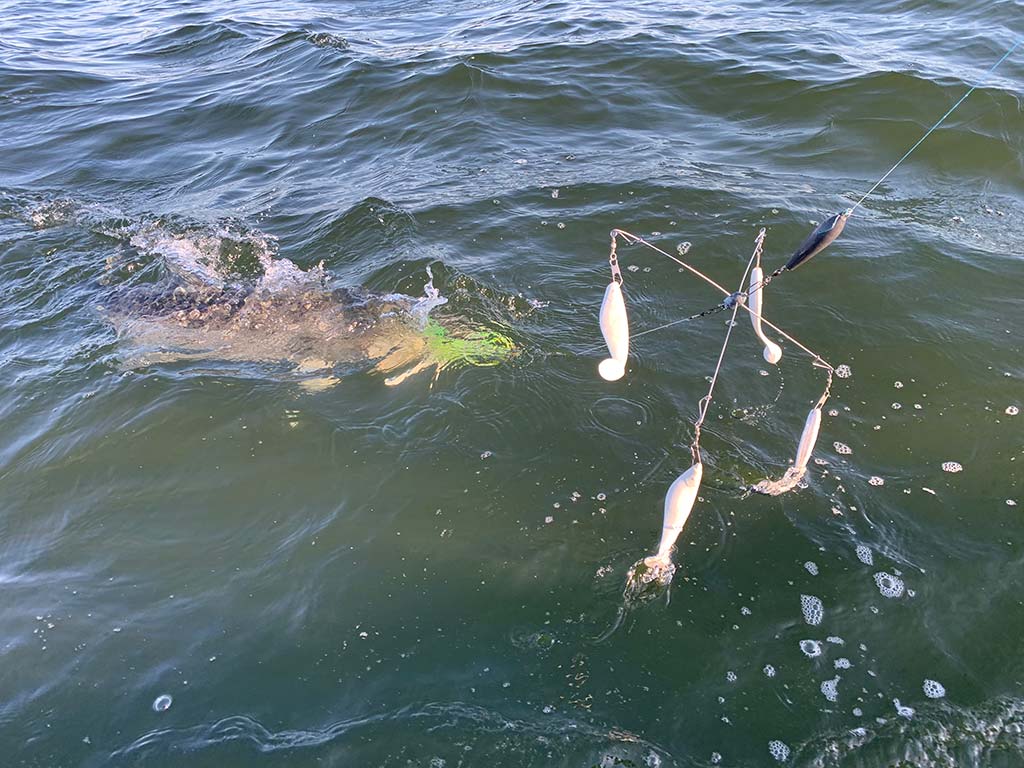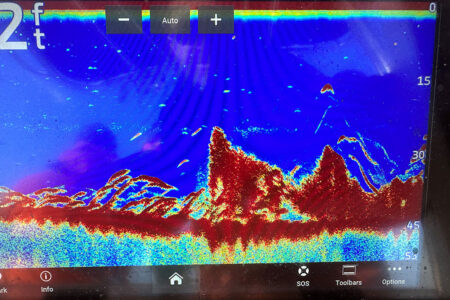
Using drail weights to get gear low in the water leads to more striped bass on the line!
“We only have shorts,” my buddy said in a vexed and disappointed voice. “What do you think we are doing wrong, we’re right next to you; the bass are here.” He was watching me and other vessels land and release quality striper after quality striper.
My friend Steve and I went through the checklist: lure choice, trolling speed, line and leader size. Finally, we came to depth control and I asked where his lures were at in the water column. He said, “We have a couple umbrellas out with no drail and the others have a 3-ounce drail.”
“Steve, I’m going to bring in my lines so you can come up to me on the port side,” I replied. “I’m going to give you a couple 6- and 8-ounce drail weights.” My buddy obliged and shortly thereafter the text came in. “We’re catching now!”
Even though we were fishing in depths that averaged 20 to 30 feet, the bigger fish were predominately near the bottom. I have found, through years of observation, that anglers trolling tackle, primarily umbrella rigs, high in the water will catch dramatically fewer fish as the day and outing moves on. Dawn patrol and top water scenarios will certainly allow anglers hook up while tackle is high in the water; however, to keep the smoke show going, it’s essential to tweak drail weight to get deep.
Captains can have the best terminal tackle there is, by all the prominent manufacturers, but if they are not within the striper’s vision, then they won’t get struck. What’s more, short bass remain high in the column often and will give anglers a false sense that their gear is in the right water segment. Eventually the realization sets in that larger fish are down low despite the readiness of smaller fish to chase near the surface.
In shallow waters from 10 to 40 feet, I like to have a full arsenal of drails that range from 2 to 8 ounces. When trolling umbrellas at depths of 40 to 80 plus feet, I obviously still have the lightweight drails at the ready, but I often run several that are 10, 12, 16 or even 20 ounces. To some, that may seem excessive, but it gets the lures tight to the bottom while I run lighter outfits such as Maja bunker spoons from the outrodders. Or I’ll deploy umbrellas with the lighter drail weights from those same wing stations on the boat.
I had been talking with Anthony Arcabascio of Tony Maja Products, a company of course squarely entrenched on the striped bass map for successful wire line trolling equipment, and he was telling me about certain situations in extremely deep water where a drail assists with bunker spoon fishing if it’s necessary to get the spoons lower in the water.
“With wire, I put the drail weight before a 12-foot section of monofilament leader. As long as there at least 10 feet of mono, it will not affect the action much,” Anthony said who added, “I’d suggest 8- to 10-ounce drail weight when fishing really deep water.”
Anthony mentioned that sometimes the fish down low aren’t feeding as aggressively and using the drail to get the spoon within ten feet of the bottom can spark a strike. If fishing braided line with bunker spoon outfits, the task becomes more daunting since the monel wire sinks far better than the braid option. “If you fish braid you have to make up for the weight, meaning a 20-ounce drail becomes necessary,” the Maja man said, explaining “Wire sinks, braid cuts and mono floats. To equal wire, braid needs weight and a decent amount.”
I doubled back in our conversation and asked again if the drail hindered action and Anthony confirmed that as long as there’s ample leader line, the spoons behave perfectly. He went on to say that his father, an accomplished striped bass angler and tackle innovator, sometimes used as much as 25 feet of monofilament leader so when a snag took place, they could go back and only lose the leader spoon as opposed to the more-costly wire. And the long leader still catches plenty of big bass!
One final suggestion is to monitor the snaps that come attached to the drails. They eventually either corrode or break from fatigue. If this happens while fishing, it can cost you a big fish and your trolling spread. When I’m fishing, I always carry extra drails in each size. Snagged and lost tackle can happen over rocky bottom when daring the fish near the ocean floor.
That, or you might need to pass some to a boating bud; helping fishing pals always comes back in catching karma.





